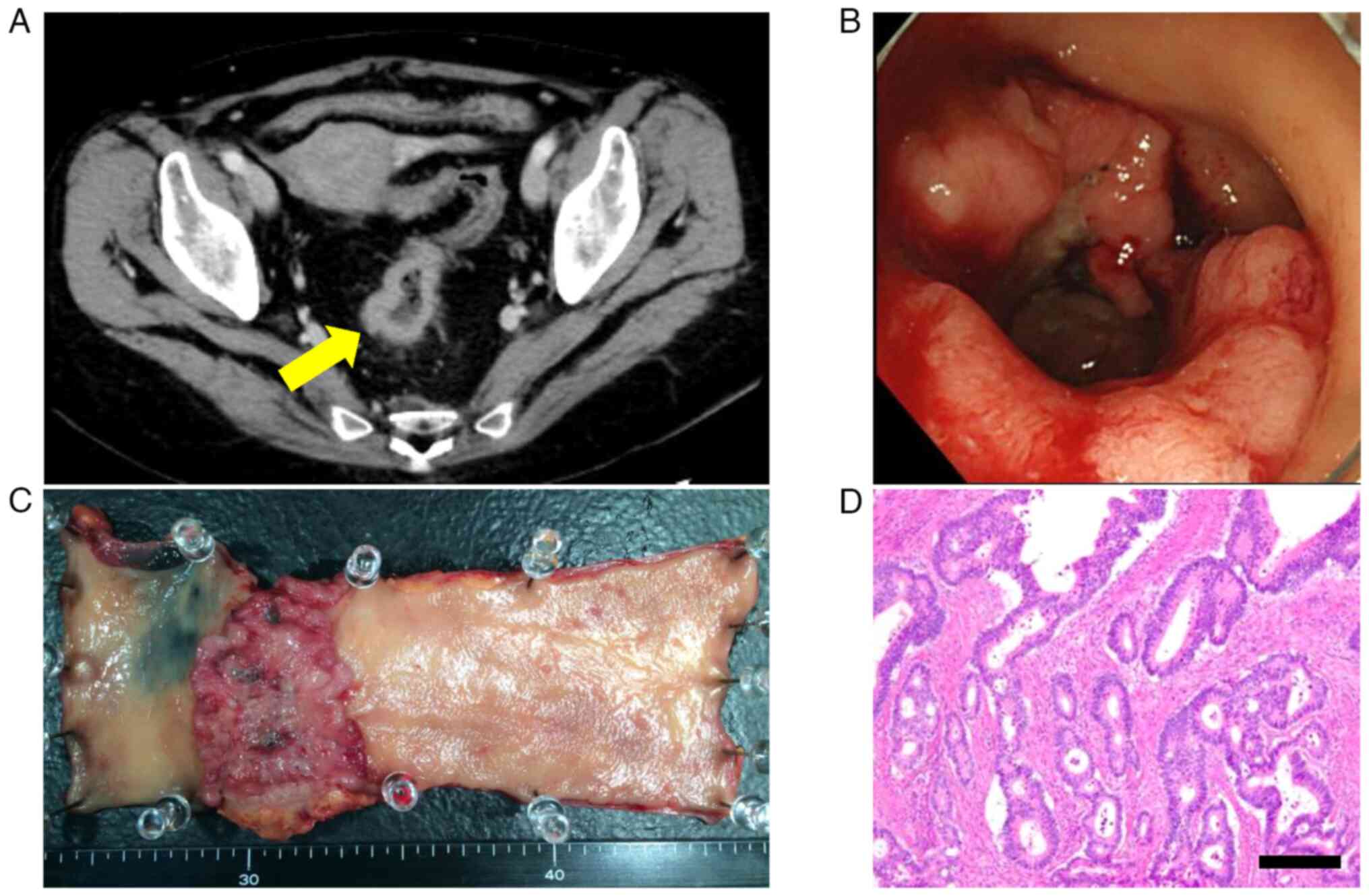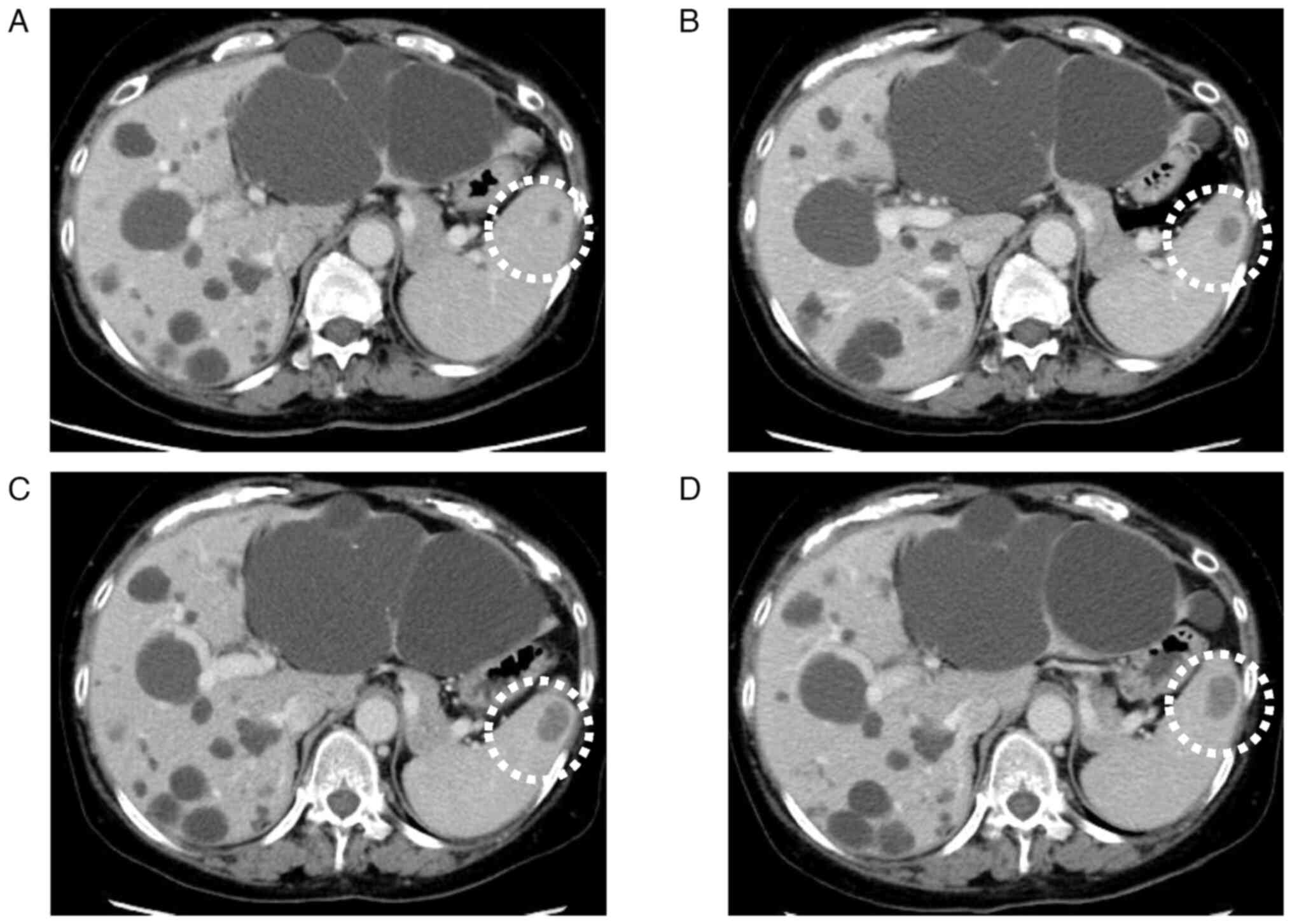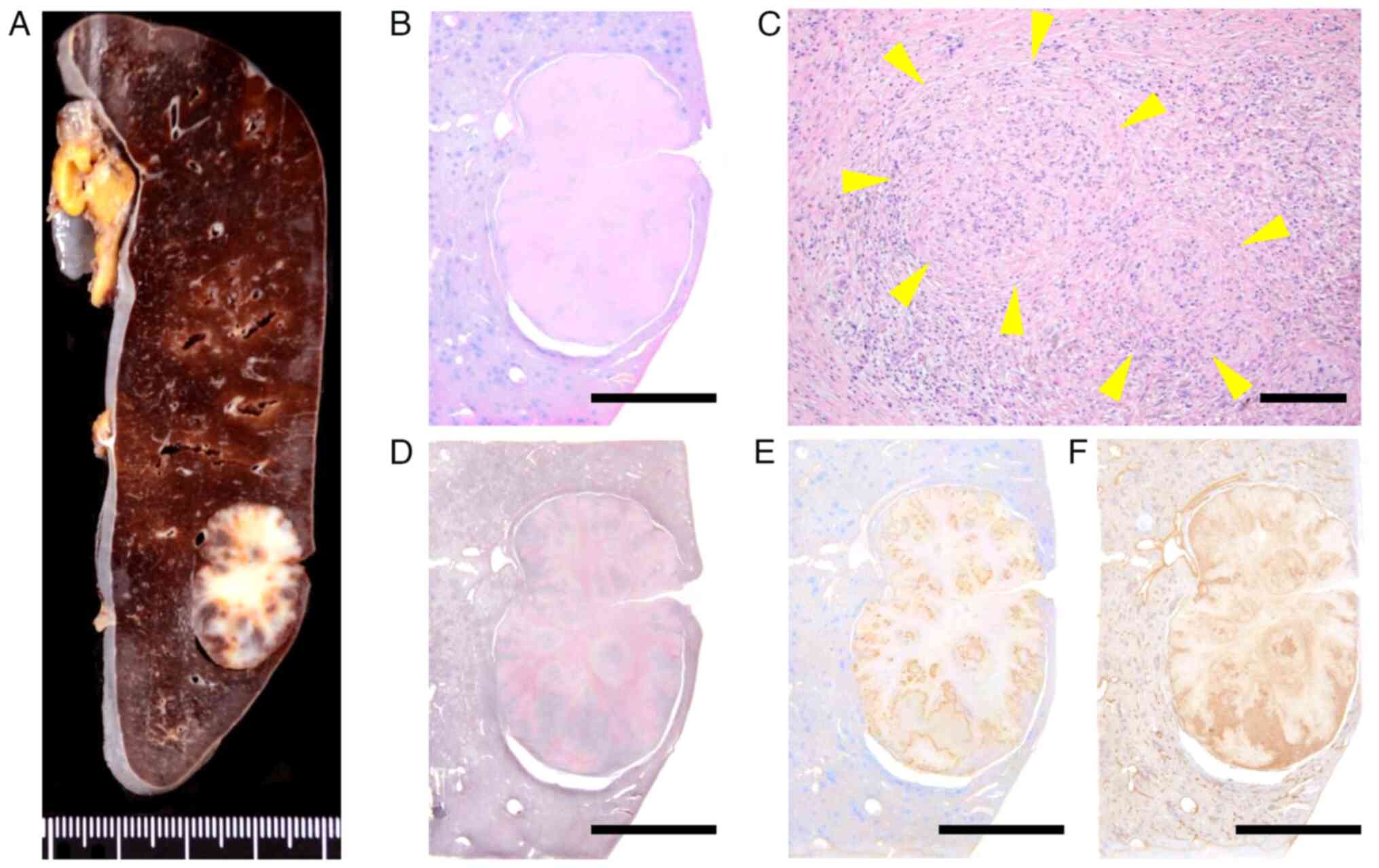Sclerosing angiomatoid nodular transformation mimicking a splenic metastasis from rectal cancer: A case report
- Authors:
- Published online on: February 18, 2025 https://doi.org/10.3892/etm.2025.12828
- Article Number: 78
Abstract
Introduction
Sclerosing angiomatoid nodular transformation (SANT) is a rare benign inflammatory tumor-like lesion of the spleen, characterized by vascular nodules and non-neoplastic stroma. Initially described by Martel et al in 2004, SANT consists of a series of benign vascular lesions exhibiting distinctive morphological features (1). Most non-lymphoid primary tumors of the spleen have a vascular origin (2). Radiological differentiation of SANT from other vascular splenic lesions, such as hamartoma, hemangioma, and littoral cell angioma, especially metastatic lesions, is often challenging because of their radiological resemblance (2). Because SANT sometimes has an ability to increase in size coupled with the potential for 18F-fluorodeoxyglucose (18F-FDG) accumulation, which is specifically a radiotracer used in the medical imaging modality positron emission tomography (PET), it is frequently misidentified as metastasis. With a differential diagnosis of malignancy, such as lymphoma or metastasis, diagnostic studies are necessary, but preoperative percutaneous procedures are frequently avoided because of potential complications, such as hemorrhage and the risk of dissemination. The possibility of metastasis remains, particularly in patients with prior malignancies. Notably, the etiology of SANT remains unclear, as does the precise pathogenesis of SANT, and it remains to be determined if it is a de novo lesion or the final common pathway of a variety of benign splenic conditions. To emphasize the clinical significance of differential diagnoses for splenic masses, we present our experience with a case wherein SANT mimicked a metachronous splenic metastasis from rectal cancer that had been successfully resected 2 years prior.
Case report
Case presentation
A 53-year-old woman with a history of hypertension and three caesarean sections was referred to Sakai City Medical Center (Osaka, Japan) for evaluation because of general fatigue, fever, and anemia in October 2017. She reported no abdominal pain, weight loss, hematochezia, or prior malignancies. Physical examination revealed no abnormalities. Laboratory tests indicated anemia (7.1 g/dl); elevated levels of lactate dehydrogenase (299 U/l), total bilirubin (1.51 mg/dl), and C-reactive protein (4.68 mg/dl); and normal levels of carcinoembryonic antigen (CEA) (3.0 ng/ml) and carbohydrate antigen 19-9 (CA 19-9) (11.8 U/ml). Contrast-enhanced computed tomography (CE-CT) was performed for rectal cancer (Fig. 1A). A total colonoscopy confirmed a circumferential rectal cancer (Fig. 1B). No distant metastases were observed. Subsequently, the patient underwent laparoscopic low anterior rectal resection and covering ileostomy. The resected tumor measured approximately 70x55 mm (Fig. 1C). Pathological evaluation indicated a moderately differentiated tumor with sub-serosal invasion, with no lymph node metastasis (0/29), and the rectal cancer was pathological stage II (Fig. 1D). The postoperative course included minor leakage at the anastomosis requiring endoluminal drainage, and discharge on day 19. Adjuvant chemotherapy was not administered. Three months later, the ileostomy was closed. Routine postoperative surveillance included CE-CT and monitoring of CEA and CA 19-9 levels, which remained within the normal range.
One year postoperatively, CE-CT revealed a low-density lesion measuring 7 mm in diameter in the spleen (Fig. 2A). While metachronous metastasis was suspected, FDG-positron emission tomography (PET) revealed no FDG accumulation in the lesion, and tumor marker levels of CEA and CA 19-9 remained within normal range. The low-density lesion was closely monitored via CE-CT for 3 years, during which it gradually enlarged to 25 mm, with no other suspicious metastatic lesions (Fig. 2B-D). The differential diagnoses included metachronous metastasis, inflammatory pseudotumors, and malignant lymphoma. Hence, the patient opted for surgical intervention. Laparoscopic splenectomy with five ports was performed successfully. The operative time was 196 min, and only 5 ml of blood was lost. Macroscopically, the resected specimen displayed a well-circumscribed, unencapsulated, nodular mass measuring 25 mm, situated just beneath the splenic capsule, with a whitish fibrotic stroma (Fig. 3A). Histological examination using hematoxylin and eosin staining revealed multiple angiomatoid nodules within the fibrosclerotic stroma (Fig. 3B and C). Each angiomatoid nodule comprised slit-like, round, or irregularly shaped vascular spaces. Reticulin staining revealed concentric layers of collagen bundles surrounding the angiomatoid nodules (Fig. 3D). Immunohistochemical analysis indicated positive expression of α-smooth muscle actin (SMA) and factor VIII (3,4) (Fig. 3E and F). Collectively, these findings supported the diagnosis of SANT. The patient's recovery was uneventful, and she was discharged 7 days postoperatively.
Immunohistochemical techniques
Tissue sections were mounted on slides and then processed for immunohistochemistry using a BOND III automated staining system (Leica, Heidelberg, Germany). After deparaffinization, epitope retrieval, and peroxidase blocking, they were incubated with an anti-human-SMA antibody (1:300; DAKO, Santa Clara, CA, USA) or an anti-human-factor-VIII antibody (1:2; Nichirei, Tokyo, Japan). Bound antibodies were detected using biotin-conjugated secondary antibodies, which reacted with diaminobenzidine (Vector Laboratories, Burlingame, CA, USA), and the sections were counterstained with hematoxylin.
Discussion
SANT is a benign lesion that is usually incidentally identified (1). Most patients with SANT are asymptomatic, primarily presenting in middle-aged adults, with a female-to-male ratio of 2:1(1). Laboratory investigations generally yield no specific findings, including those for biomarker levels. Histologically, SANT is characterized by multiple vascular nodules of angiomatoid appearance embedded in a fibrosclerotic stroma. The thick endothelial cells with spindly or ovoid cells surround the angiomatoid nodules with thin, round, or irregularly shaped vessels. In these angiomatoid nodules, three distinct types of vessels are usually seen: CD34+/CD8-/CD31+ capillaries, CD34-/CD8+/CD31+ sinusoids, and small CD34-/CD8-/CD31+ veins. Immunohistochemically, SANT typically shows positive expression of α-SMA, and factor VIII (3,4). The precise pathogenesis of SANT is unclear, and it remains to be determined if it is a de novo lesion or the final common pathway of a variety of benign splenic conditions. Passive congestion of the red pulp may cause metabolic changes in those areas, damaging the sinus endothelial cells. Such damage may lead to fibrin deposition and inflammation, culminating in granulation within the red pulp (5). Martel et al hypothesized that SANT is a response to stromal proliferation and that the internodular zones resemble an inflammatory pseudotumor (1). The plasma cells and stromal sclerosis present in SANT have been connected to IgG4-related sclerosing disease (6,7). Recently, Epstein–Barr virus-related sclerosing conditions have been associated with SANT (8). Unfortunately, the values of IL-2 or IgG4 were not measured in our case. To achieve a preoperative radiological diagnosis, standard imaging techniques, including abdominal ultrasound, CT, and magnetic resonance imaging, typically describe SANT as a hypodense, occasionally multinodular splenic mass (2,9). In our case, MRI was not performed for splenic lesions. The differential diagnosis of a hypodense mass in the spleen includes malignant lesions, such as lymphoma or metastasis, and benign lesions, such as hemangioma, littoral cell angioma, hemangioendothelioma, and splenic hamartoma. Splenic hemangioma is often composed of cavernous capillary vessels expressing CD31 and CD34, but not CD8. Hemangioma actually shows regressive changes, such as infarction, fibrosis, and cystic degeneration, while hemangioma does not display the distinctive angiomatoid nodular appearance of SANT (10). Littoral cell angioma is composed of sinusoid lining cells. Although these cells normally represent CD31+/CD34-/CD8+ cells as a putative counterpart, some cells that do not fully reproduce show an immunophenotype such as CD31+/CD34-/CD8-. Littoral cell angioma is distinctive from SANT, because it shows monotonous blood vessel composition without sclerosis. Hemangioendothelioma is a very rare tumor with borderline malignant potential, showing clinical and morphological features intermediate between those of hemangioma and angiosarcoma. It is composed of ill-defined vascular spaces lined by cells with mild-to-moderate cellular atypia and generally a low mitotic index (11). SANT can be distinguished from hemangioendothelioma because of its low proliferative index and because it lacks cytologic atypia. Splenic hamartoma has been defined as a tumor-like lesion composed of structurally disorganized red pulp tissue. Hamartoma, however, lacks an angiomatoid nodular pattern, and does not show a clear border, in contrast to SANT.
Splenic metastasis is rare and generally occurs in the context of multi-visceral metastatic cancer at the terminal stage, although solitary metastasis has been reported (12). Given the propensity of SANT to increase in size coupled with the potential for FDG accumulation, it is frequently misidentified as metastasis (9,13). In our case, the patient was asymptomatic, and with no increase of tumor marker levels. During a 3-year follow-up period after the initial detection of the splenic lesion following curative rectal cancer surgery, the low-density lesion gradually enlarged to 25 mm, despite FDG-PET showing no FDG accumulation. The possibility of metastasis remains, particularly in patients with prior malignancies (12). With a differential diagnosis of malignancy, such as lymphoma or metastasis, diagnostic studies are necessary, but preoperative percutaneous procedures are frequently avoided because of potential complications, such as hemorrhage and the risk of dissemination (14). In our case, a preoperative biopsy was also avoided because of concerns regarding bleeding and needle-tract seeding. In such cases, splenectomy may be performed.
To date, nine cases of SANT, including the case presented here, have been reported in patients with a history of cancer treatment (14-21). These nine cases involved five males and four females. The tumors ranged from 2 to 7 cm in diameter, and the patients had histories of melanoma; retroperitoneal sarcoma; and rectal, breast, uterine, ovarian, and renal cancers. In two instances, preoperative biopsies were conducted. One patient was diagnosed with SANT, which was managed with 9 years of surveillance, during which, there was no malignant transformation or recurrence (14). In another case, preoperative biopsy erroneously indicated metastasis, leading to splenectomy, which confirmed SANT on pathological analysis (17). In two cases, splenectomy was performed alongside the initial surgeries for malignancies where metastasis was suspected, whereas in the remaining cases, splenectomy was performed following a period of observation lasting up to 5 years. SANT is a benign splenic condition with good prognosis. To date, there have been no reports of recurrence after splenectomy (22).
When a splenic lesion is incidentally identified, particularly during the follow-up of a previous cancer treatment, SANT should be considered as a differential diagnosis. In cases connected to prior malignancies, splenectomy is essential for both diagnostic and therapeutic purposes. Incorporating data from multicenter studies or additional cases for retrospective and statistical analysis or a comprehensive study using a larger sample size are required.
Acknowledgements
Not applicable.
Funding
Funding: No funding was received.
Availability of data and material
The data generated in the present study may be requested from the corresponding author.
Authors' contributions
HT, MN, YY, AK and AM contributed to the diagnosis and treatment of the patient. HT and MM made substantial contributions to conception and design. HT, AK, YY and MN made substantial contributions to acquisition of data. HT, MM, TY, NO, TT, HH, AN, RK, SN and AM made substantial contributions to analysis and interpretation of data. HT wrote the first draft of the manuscript. HT and MM confirm the authenticity of all the raw data. All of the authors are accountable for all aspects of the work, and read and approved the final version of the manuscript.
Ethics approval and consent to participate
Not applicable.
Patient consent for publication
Written informed consent was obtained from the patient for the publication of this case report and any accompanying images.
Competing interests
The authors declare that they have no competing interests.
References
|
Martel M, Cheuk W, Lombardi L, Lifschitz-Mercer B, Chan JK and Rosai J: Sclerosing angiomatoid nodular transformation (SANT): Report of 25 cases of a distinctive benign splenic lesion. Am J Surg Pathol. 28:1268–1279. 2004.PubMed/NCBI View Article : Google Scholar | |
|
Abbott RM, Levy AD, Aguilera NS, Gorospe L and Thompson WM: From the archives of the AFIP: Primary vascular neoplasms of the spleen: Radiologic-pathologic correlation. Radiographics. 24:1137–1163. 2004.PubMed/NCBI View Article : Google Scholar | |
|
Kashiwagi S, Kumasaka T, Bunsei N, Fukumura Y, Yamasaki S, Abe K, Mitani K, Abe H, Matsumoto T and Suda K: Detection of Epstein-Barr virus-encoded small RNA-expressed myofibroblasts and IgG4-producing plasma cells in sclerosing angiomatoid nodular transformation of the spleen. Virchows Archiv. 453:275–282. 2008.PubMed/NCBI View Article : Google Scholar | |
|
Kim HH, Hur YH, Koh YS, Kim JC, Kim HJ, Kim JW, Kim Y, Lee JH and Cho CK: Sclerosing angiomatoid nodular transformation of the spleen related to IgG4-associated disease: Report of a case. Surg Today. 43:930–936. 2013.PubMed/NCBI View Article : Google Scholar | |
|
Diebold J, Le Tourneau A, Marmey B, Prevot S, Müller-Hermelink HK, Sevestre H, Molina T, Billotet C, Gaulard P, Knopf JF, et al: Is sclerosing angiomatoid nodular transformation (SANT) of the splenic red pulp identical to inflammatory pseudotumour? Report of 16 cases. Histopathology. 53:299–310. 2008.PubMed/NCBI View Article : Google Scholar | |
|
Kuo TT, Chen TC and Lee LY: Sclerosing angiomatoid nodular transformation of the spleen (SANT): Clinicopathological study of 10 cases with or without abdominal disseminated calcifying fibrous tumors, and the presence of a significant number of IgG4+ plasma cells. Pathol Int. 59:844–850. 2009.PubMed/NCBI View Article : Google Scholar | |
|
Nagai Y, Hayama N, Kishimoto T, Furuya M, Takahashi Y, Otsuka M, Miyazaki M and Nakatani Y: Predominance of IgG4+ plasma cells and CD68 positivity in sclerosing angiomatoid nodular transformation (SANT). Histopathology. 53:495–498. 2008.PubMed/NCBI View Article : Google Scholar | |
|
Weinreb I, Bailey D, Battaglia D, Kennedy M and Perez-Ordoñez B: CD30 and Epstein-Barr virus RNA expression in sclerosing angiomatoid nodular transformation of spleen. Virchows Archiv. 451:73–79. 2007.PubMed/NCBI View Article : Google Scholar | |
|
Lee D, Wood B, Formby M and Cho T: F-18 FDG-avid sclerosing angiomatoid nodular transformation (SANT) of the spleen: Case study and literature review. Pathology. 39:181–183. 2007.PubMed/NCBI View Article : Google Scholar | |
|
Kutok JL and Fletcher CD: Splenic vascular tumors. Semin Diagn Pathol. 20:128–139. 2003.PubMed/NCBI View Article : Google Scholar | |
|
Budke HL, Breitfeld PP and Neiman RS: Functional hyposplenism due to a primary epithelioid hemangioendothelioma of the spleen. Arch Path Lab Med. 119:755–757. 1995.PubMed/NCBI | |
|
Compérat E, Bardier-Dupas A, Camparo P, Capron F and Charlotte F: Splenic metastases: Clinicopathologic presentation, differential diagnosis, and pathogenesis. Arch Path Lab Med. 131:965–969. 2007.PubMed/NCBI View Article : Google Scholar | |
|
Feng YM, Huang YC, Tu CW, Kao WS and Tu DG: Distinctive PET/CT features of splenic SANT. Clin Nucl Med. 38:e465–e466. 2013.PubMed/NCBI View Article : Google Scholar | |
|
Dutta D, Sharma M, Mahajan V and Chopra P: Sclerosing angiomatoid nodular transformation of spleen masquerading as carcinoma breast metastasis: Importance of splenic biopsy in obviating splenectomy. Indian J Pathol Microbiol. 59:223–226. 2016.PubMed/NCBI View Article : Google Scholar | |
|
Langer R, Dinges J, Dobritz M, Brauer RB, Perren A, Becker K and Kremer M: Sclerosing angiomatoid nodular transformation of the spleen presenting as a rapidly growing tumour in a patient with rectal cancer. BMJ Case Rep. 2009(bcr11.2008)2009.PubMed/NCBI View Article : Google Scholar | |
|
Sitaraman LM, Linn JG, Matkowskyj KA and Wayne JD: Sclerosing angiomatoid nodular transformation of the spleen masquerading as a sarcoma metastasis. Rare Tumors. 2(e45)2010.PubMed/NCBI View Article : Google Scholar | |
|
Demirci I, Kinkel H, Antoine D, Szynaka M, Klosterhalfen B, Herold S and Janßen H: Sclerosing angiomatoid nodular transformation of the spleen mimicking metastasis of melanoma: A case report and review of the literature. J Med Case Rep. 11(251)2017.PubMed/NCBI View Article : Google Scholar | |
|
Lapa C, Steger U, Ritter CO, Wild V and Herrmann K: Differentiation of an unclear splenic lesion in a patient with cholangiocarcinoma. Clin Nucl Med. 39:470–471. 2014.PubMed/NCBI View Article : Google Scholar | |
|
Efared B, Sidibé IS, Erregad F, Hammas N, Chbani L and El Fatemi H: Sclerosing angiomatoid nodular transformation of the spleen (SANT) in a patient with clear cell carcinoma of the uterus: A case report. J Med Case Rep. 12(377)2018.PubMed/NCBI View Article : Google Scholar | |
|
Koyama R, Minagawa N, Maeda Y, Shinohara T and Hamada T: A sclerosing angiomatoid nodular transformation (SANT) mimicking a metachronous splenic metastasis from endometrioid cancer and ovarian cancer. Int J Surg Case Rep. 65:292–295. 2019.PubMed/NCBI View Article : Google Scholar | |
|
Zhang ZB and Li L: Splenic sclerosing angiomatoid nodular transformation in a patient with right renal carcinoma: A case report. Asian J Surg. 44:396–397. 2021.PubMed/NCBI View Article : Google Scholar | |
|
Xia L, Li Z, Jiang P, Zhang Y, Bu Z and Meng N: Sclerosing angiomatoid nodular transformation of the spleen: Case reports and literature review. Medicine (Baltimore). 103(e38466)2024.PubMed/NCBI View Article : Google Scholar |













